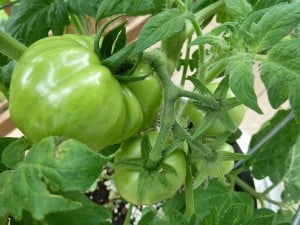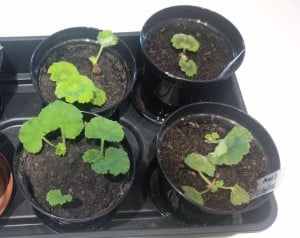Protect tender plants and take the tomatoes in hand this autumn
As the cooler weather of autumn arrives, it’s time for us to help the last of the tomatoes to ripen and to protect more tender plants.
Time has flown and here we are in September. Like it or not, the summer is bowing out and the autumn’s gales and rain will soon be coming on stage. Perhaps not straightaway (I’m quite happy to accept some of those lovely Indian summer days first) but cooler air will be here in due course.
Take the tomatoes in hand
Light levels are starting to drop and tomato plants are slowing down. Keep picking the ripened fruit and remove all the leaves so that absolutely all the plant’s energy is put into the tomatoes.
After a while, though, the tomatoes will seem to stop ripening. There are three ways I know to encourage ripening.
- Take off the trusses (don’t pick off the individual tomatoes) and lay them on cardboard or newspaper in a sunny place indoors.
- Pull up the entire plant gently and hang it upside in a cool place (like a garage).
- Put the green tomatoes in an enclosed space (like a paper bag) with fruit that naturally gives off ethylene, the ripening hormone. A banana works very well. You could also try an apple or a pear. Or a ripe tomato!

Green tomatoes on vine
© Chris Haines, licensed under the Creative Commons Attribution-Share Alike 3.0 Unported licence.
Start to protect tender plants from rain, cold and wind
It may seem very early to start thinking like this but rain, cold and wind are in our future. And the weather is full of surprises. Best to plan ahead.
The amount of protection your plants will need depends on how exposed your garden is. Tender plants in some sheltered city gardens may not need any protection at all. Those in gardens located in the teeth of raging autumnal gales need your help now.
Move plants into shelter to protect them
Houseplants that have been outside for a summer holiday, benefitting from fresh air and rain to clean their leaves, should be moved back indoors.
Winter containers do better near a wall or in a sheltered corner rather than in an exposed spot. But avoid soggy or too damp spots.
Other plants are better in a cool and frost-free place. That’s not so easy if you haven’t got a garage, shed or porch but Lia Leendertz has solved the problem to some extent with a mini-greenhouse next to her kitchen.
And be realistic: pull up any plants that aren’t going to make it through the first frosts, such as outdoor bush tomatoes and tender annuals.
Stake and batten down
Stake plants which are going to stand the winter, like cabbages, kale and other winter greens. Push a short cane or stick close to the plant stem and tie them together. Tidy away, or batten down, anything that might fly off.
Protect from puddles
Make sure containers don’t sit in puddles (put them on feet or bricks) or under overflowing drainpipes or gutters.
Spread horticultural grit around plants that don't like to be too wet (especially those in containers and herbaceous perennials that like a dry-ish soil) to stop moisture collecting around them and the rot setting in.
Protect by covering and insulating
Most of us are not quite at frost levels yet (!) but think ahead to be sure of a good display from your plants next year.
Put a good layer (5 - 15cm / 2 - 6 inches) of mulch around tender plants to insulate their crowns against frost and to keep the roots warm. You could use compost, shreddings, leaves, straw or bark. As the mulch breaks down over the winter it will add organic matter to the soil and improve the drainage. Some gardeners leave some of the year's soft growth as a canopy for the winter and clear it away in spring.
Wrap your plants up warmly, if necessary, but also let them breathe! Air must circulate and moisture must evaporate if plants are not to get all sweaty and rot. You could use horticultural fleece (it's very light) or straw, tied around the base of the plant. Hessian sacking or old blankets work too but are quite heavy when wet. Newspaper blows away in the wind or gets very wet but is a good temporary cover for the night you just know the frost or wind is coming and you are not ready. And bubble wrap is OK for pots, but not for the plants themselves as it doesn’t allow them to breathe enough. With all insulation material, you may have to take it off and put it on, just like we do with our jumpers.
Anything else to cover? You’ve got covers for your garden furniture?
Have an insurance policy
Take cuttings of your favourite plants (I've done this with some pelargoniums and fuchsias) in case they don't survive.
Where did the summer go?
To round off, I’d like to put it on record that I’m always happy to welcome autumn. It’s probably my favourite season. But I have to ask: where did the summer go?
Sign up for our emails below, so we can send you blogs on gardening tips, as well as updates on our sales, so you don’t miss out on those garden furniture bargains!









